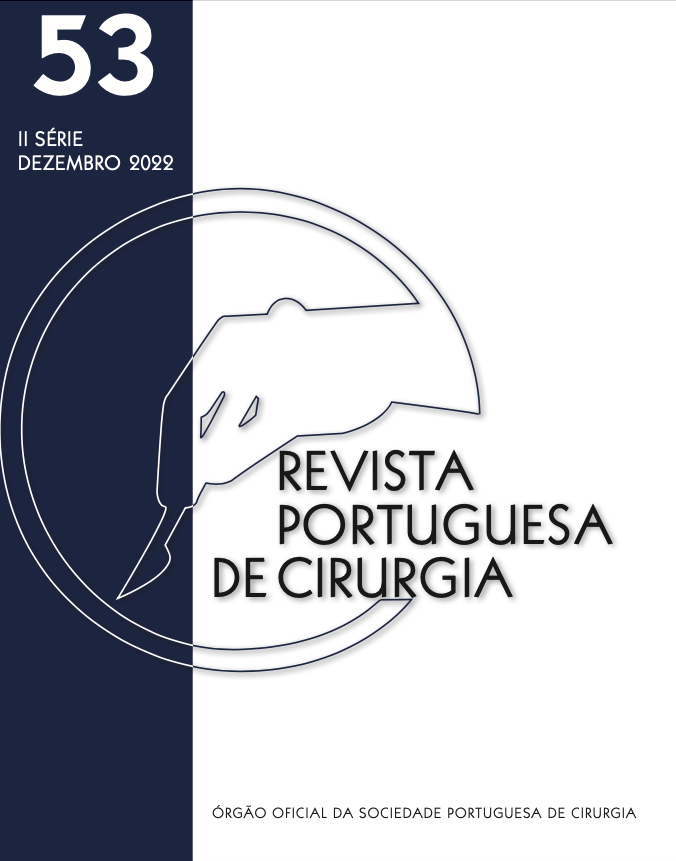GASTRIC OUTLET OBSTRUCTION BY CAUSTIC INGESTION: CASE REPORT OF AN EARLY DEFINITIVE SURGICAL APPROACH
DOI:
https://doi.org/10.34635/rpc.848Keywords:
Caustic ingestion, Pyloric stenosis, Gastric outlet obstruction, GastrectomyAbstract
Introduction: Ingestion of caustic products present a challenge to many physicians, as it remains a rare occurrence in the emergency room.
Presentation of Case: A 58-year-old male was brought to the emergency department after ingesting hydrochloric acid. A pre-pyloric stenosis developed and endoscopic dilation was attempted with no success. The patient underwent an open subtotal gastrectomy after 4 weeks, with no complications and significant clinical improvement.
Discussion: Gastric outlet obstruction mainly occurs in the prepyloric area. A surgical approach is reported as a safe alternative after the acute inflammatory phase subsided, and can be safely executed 4 weeks after the caustic ingestion if needed. The type of resection should be tailored to the extent of the lesions.
Conclusion: Surgical resection poses a safe alternative, after the acute inflammatory phase has subsided and allows for adequate symptomatic control. Liquid agents affect mostly areas where pooling occurs, being the gastric antrum a frequent area where caustic lesions take place.
Downloads
References
2. K.S. Park, Evaluation and management of caustic injuries from ingestion of acid or alkaline substances, Clin. Endosc. 47 (2014) 301–307. doi:10.5946/ce.2014.47.4.301.
3. M.U. Hashmi, M. Ali, K. Ullah, A. Aleem, I.H. Khan, Clinico-epidemiological Characteristics of Corrosive Ingestion: A Cross- sectional Study at a Tertiary Care Hospital of Multan, South-Punjab Pakistan, Cureus. 10 (2018). doi:10.7759/cureus.2704.
4. S. Contini, C. Scarpignato, Caustic injury of the upper gastrointestinal tract : A comprehensive review, 19 (2013) 3918–3930. doi:10.3748/wjg.v19.i25.3918.
5. X. Chen, B. Huang, H.-W. Wan, Epidemiologic Features and Outcomes of Caustic Inges- tions; a 10-Year Cross-Sectional Study, Chinese J. Tissue Eng. Res. 17 (2013) 5705–5710. doi:10.3969/j.issn.2095-4344.2013.31.020.
6. B.L. Meena, K.S. Narayan, G. Goyal, S. Sultania, S. Nijhawan, Corrosive Injuries of the Upper Gastrointestinal Tract, J. Dig. Endosc. 8 (2017) 81–82. doi:10.4103/jde.JDE.
7. A.I. Vezakis, E. V. Pantiora, E.A. Kontis, V. Sakellariou, D. Theodorou, G. Gkiokas, A.A. Polydorou, G.P. Fragulidis, Clinical spectrum and management of caustic ingestion: A case series presenting three opposing outcomes, Am. J. Case Rep. 17 (2016) 340–346. doi:10.12659/AJCR.897778.
8. D.D. Gummin, J.B. Mowry, D.A. Spyker, D.E. Brooks, K.M. Osterthaler, W. Banner, 2017 Annual Report of the American Association of Poison Control Centers ’ National Poison Data System ( NPDS ): 35th Annual Report, (2018).
9. Y. Kluger, O. Ben Ishay, M. Sartelli, A. Katz, L. Ansaloni, C.A. Gomez, W. Biffl, F. Catena, G.P. Fraga, S. Di Saverio, A. Goran, W. Ghnnam, J. Kashuk, Caustic ingestion management : world society of emergency surgery preliminary survey of expert opinion, World J. Emerg. Surg. (2015) 1–8. doi:10.1186/s13017-015-0043-4.
10. A. Methasate, V. Lohsiriwat, Role of endoscopy in caustic injury of the esophagus, World Journal of Gastrointestinal endoscopy, 9 (2018) 157–164. doi:10.5321/wjs.v2.i3.40.
11. CE McAuley, DL Steed, MW Webster. Late sequelae of gastric acid injury. Am J Surg. 1985 Mar;149(3):412-5. doi: 10.1016/ s0002-9610(85)80121-5.
12. H Eaton, GE Tennekoon. Squamous carcinoma of the stomach following corrosive acid burns. Br J Surg. 1972 May;59(5):382-7. doi: 10.1002/bjs.1800590514.
Downloads
Published
Issue
Section
License
Para permitir ao editor a disseminação do trabalho do(s) autor(es) na sua máxima extensão, o(s) autor(es) deverá(ão) assinar uma Declaração de Cedência dos Direitos de Propriedade (Copyright). O acordo de transferência, (Transfer Agreement), transfere a propriedade do artigo do(s) autor(es) para a Sociedade Portuguesa de Cirurgia.
Se o artigo contiver extractos (incluindo ilustrações) de, ou for baseado no todo ou em parte em outros trabalhos com copyright (incluindo, para evitar dúvidas, material de fontes online ou de intranet), o(s) autor(es) tem(êm) de obter, dos proprietários dos respectivos copyrights, autorização escrita para reprodução desses extractos do(s) artigo(s) em todos os territórios e edições e em todos os meios de expressão e línguas. Todas os formulários de autorização devem ser fornecidos aos editores quando da entrega do artigo.



